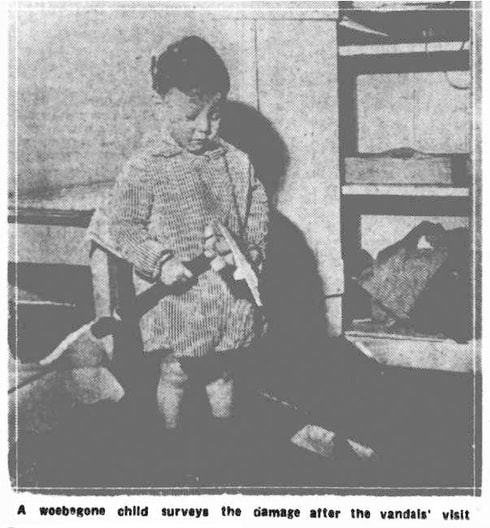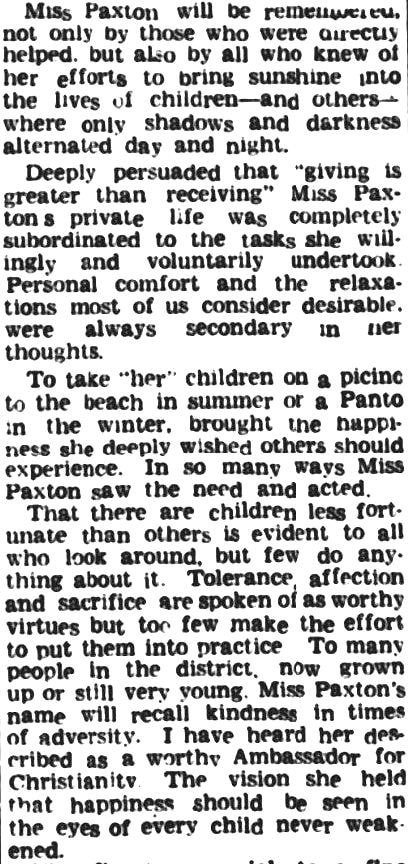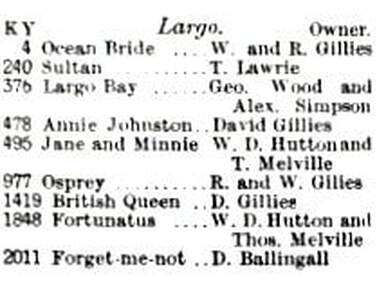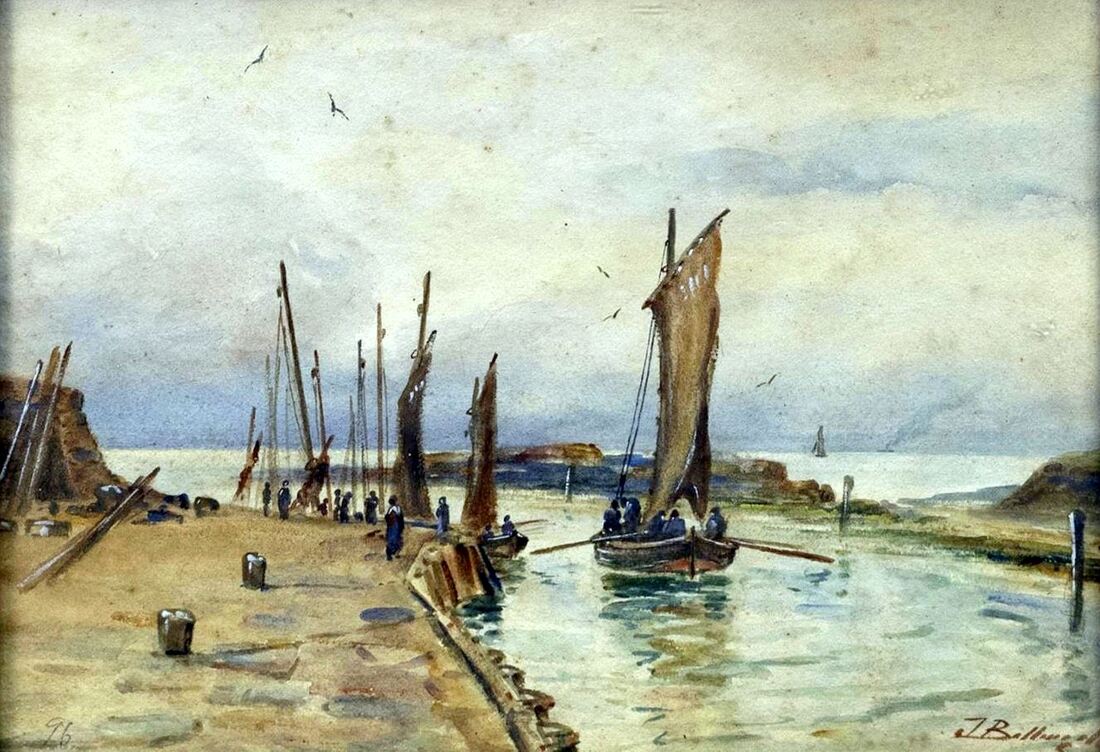Janet Hamilton Paxton (known as Jessie) was born in 1895 in San Antonio, Texas, USA. She was the eldest child of rancher Robert Carswell Paxton and his wife Margaret Donald Baird. Robert Paxton was born into an Ayrshire brewery-owning family. While his elder brother George continued the brewery business, Robert emigrated to America in 1878, aged about 25, to become one of the first settlers in Terrell County, Texas. The area which he settled is now known as the Longfellow Ranch. Robert established a sheep station prior to his marriage to Margaret Donald Baird at the age of 41 on 25 October 1894 in Kilmarnock. On the marriage certificate his occupation is ‘sheep farmer’. Their first child Jessie was born the following year. Robert eventually diversified into cattle as well as sheep. Terrell County would go on to become one of the USA’s largest sheep and wool producers.
In July 1899, Robert, Margaret and a 4-year-old Jessie travelled from New York to Glasgow. While Robert's sheep and cattle ranch continued, the family sought a return to Scotland. Two years later in the 1901 census, Jessie and both her parents were recorded at 25 Blacket Place in Edinburgh. This was the rented home of Robert's sister Janet Muir Paxton. Robert Paxton's occupation was given in the census as "Ranchman in Texas". By 1902 the Paxtons had identified Lundin Links as a suitable place to live and were renting Drum Lodge. During the 2-3 years that they family lived there, Jessie's sisters were born - Margaret Baird Paxton on 17 February 1902 and Isabella Carse Paxton on 22 June 1904. The Paxtons then moved to Elphinstone on Crescent Road in 1905 (pictured below) and the family's fourth daughter and youngest child, Emily, was born there in 1907. The following year Homelands came up for sale and it became the permanent family home.
Robert continued to travel periodically to Texas, while also being involved in local life in Fife. He was Captain of Lundin Golf Club 1908-09 and appears in the photograph above at the opening of the Lundin Ladies new course on 15 April 1910. Jessie is likely the young woman in the centre back row with the wide-brimmed hat, standing between her parents. At the time of the 1911 census both Jessie and her father were absent from Homelands. It's probable that both were in the USA.
Tragically, on 3 April 1912, the Paxtons' youngest daughter Emily died at Homelands, aged 4. That same year Robert sold the Texas ranch. However, this was not the end of the USA connection and in 1914 Jessie travelled to visit the country of her birth aboard the ship Colombia, from Glasgow to New York. Shortly afterwards, the First World War began and the Paxtons swung into action to support aid efforts. For four and a half years, the Lundin Links Red Cross work party was based at Homelands, with Mrs Paxton as convener. The Paxton family became firmly established in the community of Lundin Links and beyond. The three Miss Paxtons were all involved in amateur dramatics and well as charitable activities. The photograph below from the 9 February 1931 Dundee Courier shows Jessie (front row, extreme right), Isabel (next to Jessie) and Margaret (centre, back row) coming second in the Scottish Community Drama Festival (Kirkcaldy Section) in the Adam Smith Theatre, as part of the Lundin Amateur Dramatic Society team.
It was in the early 1930s that Jessie Paxton found her calling in life. The Leven Advertiser of 15 Feb 1938 refers to how she was first inspired by “a casual visit to a home in London run by former pupils of St Leonards School, St Andrews". Jessie then spent a couple of years training in London, most likely at the Rachel Macmillan Nursery School College in East London. To view a short film of a typical day there around that time - click here. It was in 1930 that the training centre was given full college status, so Jessie would have been one of the early graduates.
Rachel and Margaret McMillan were sisters and nursery school pioneers. Both born in the USA to Scottish parents, they returned to Scotland as children. As young women they became suffragists and socialists, eventually focussing their attention on the needs of young children and the belief that they needed the opportunity to develop and learn by being healthy, clean and well fed. They ran the first nursery schools in the country, placing great importance upon imaginative play, time outdoors, nourishing food and allocated time for sleep.
Although Rachel died in 1917, Margaret continued their work, writing several books about nursery education. She gave many speeches about the needs of the poorest children in society and the value of nursery education. By the end of the First World War, Margaret McMillan was considered an expert in nursery education. When she died in 1931, she had established a philosophy of nursery education and nursery schools as open-air institutions that continues to influence practice today. You can read much more about her life here.
Sharing this genuine interest in the welfare of the very young, and now with the necessary training under her belt, Jessie Paxton searched Fife for a suitable premises in which to open her own nursery. The rent-free use of Lindsay's Square Hall and two adjoining houses in Methil (marked on the map below) was granted by Charles Carlow of Fife Coal Company. The buildings were adapted for use as a small nursery school (with a playroom, bathroom and kitchen). Furniture for the nursery was made by three unemployed men (Messrs Deblin, Cargill and Allan) who were members of the Leven Unemployed Social Service Centre at Albion House. They spent several weeks making tiny tables, chairs and stretcher beds which were painted bright blue.
Toys were also made locally, and food donated by generous supporters. Eighteen children aged between three and a half and four years old started on Tuesday 26 November 1935, with younger children starting the Monday after. The above photograph from the 29 November 1935 Courier shows a beaming Jessie with two of the first pupils. The facility was opened without any expenditure from public funds. The initial expense of adapting the building and early running costs came from private subscriptions. Efforts were made to keep costs relatively low and parents of pupils paid just one shilling per week. In the early days, aside from two young nursemaids who received wages, all work was voluntary. Despite all of that, the nursery was viewed with hostility from some parts of the community (and that persisted for many years among those that saw pre-school child welfare as the domain of parents).
In February 1936 Provost William Smart wrote in the Leven Advertiser about a typical day at the nursery. An extract from this report is below. Being too young to read, each child had their own unique picture to identify their peg and other belongings. They wore light brown overalls, had porridge for breakfast and played singing games afterwards. A nutritious lunch was followed by a spoonful of malt and halibut oil. A toothbrushing drill preceded rest hour, where pupils napped on individual beds with their own blankets (an unpopular part of the day for the older ones).
Toys available included blackboards, string beads, peg boards and wooden blocks - designed to train the hands and eyes. Tea was brown bread with jam and milk drunk out a bottle with a straw. The floor was blue linoleum and the walls painted yellow at the top and brown below. The fire blazed to keep the place warm. Smart described a "happy and joyful picture" with children aged 2 to 5 "eagerly busy". Jessie, her nursemaids and a long string of tiny tots became a familiar sight in the streets close to the nursery as they took their daily walk. In those early days, many of the bairns attending came from families struggling with overcrowding, poverty or poor health (or sometimes all three). Gaining a place at the nursery could revolutionise their lives.
While the nursery thrived, the surrounding houses of Lindsay's Square had been earmarked for demolition. Built to house miners, these were now very old and, with their dirt floors and lack of plumbing, were no longer deemed fit for human habitation. Their demolition began in 1935 and continued into 1936. The disruption of this work, going on adjacent to the nursery, must have been considerable. Initially, it was hoped that the redevelopment of the site would include provision to expand the nursery, allowing more children to attend. By 1937, there were 48 children in the Methil nursery and a waiting list of 60. Miss Paxton spoke of one three-year-old boy that used to stand at the gate every day, tears running down his face, saying "I'm wantin' in. I'm wantin' in". He eventually got in but there were many more like him still waiting.
Around the time that the County Council had purchased the old Lindsay Square housing from the Fife Coal Company, the Council's Education Committee had formally recognised the nursery and begun to provide a grant towards running expenses. So, it seemed hopeful that an additional building for the nursery to expand into might be created within the redeveloped Lindsay Square area. However, the priority of the Buckhaven and Methil Town Council was to build houses. Their suggestion was to wait and assess the available space after the housing had been completed. Jessie, believing that the need for additional space for the nursery was both great and urgent, began negotiations with other potential sites. By November 1938, the waiting list had grown to 115 children.
The nursery now had to deal with the disruption of the construction of the new housing at the site (which would become St Andrew's Square) and as the 1930s drew to a close, the Second World War put an end to all plans to extend or relocate the nursery. Wartime brought fresh challenges, around food supply, staffing shortages and general uncertainty. However, Miss Paxton's nursery continued to operate through that difficult period and emerged ready to revisit expansion plans. Finally, on 5 September 1949 a second nursery opened at Kirkland Drive. The premises were a former National Fire Service hut, purchased from the Freemasons and adapted for its new use. The number of children attending across the two sites rose to almost 100,
The 7 September 1949 Leven Mail covered the opening and included the two photographs below. Reconditioned rocking horses had been brought up from the Lower Methil nursery and other toys had been brought in by well-wishers, including a beautiful miniature horse-drawn carriage. Each child had their own particular favourite plaything. The new nursery started with 13 children but would quickly progress to accommodate 25 to 30. Even with a second building, there were ongoing calls upon the Buckhaven and Methil Council to find a more substantial and permanent premises for the nursery.
When the Kirkland Drive nursery was targeted by vandals in May 1954, Miss Paxton explained that "this was not a very surprising discovery" as "they have been doing this sort of thing since 1936" and that she had lost count of the number of windowpanes that had had to be replaced over the years. On this occasion, vandals had smashed a rocking horse and barrow, strewn the laundry about and broken three windows. The little ones arriving the next morning were puzzled as to why this had happened, and the poignant image above appeared in the 2 June Leven Mail. The little boy is holding the broken handle of the rocking horse.
Jessie's vision and determination were recognised when she was awarded an MBE in 1956 for her pioneering work. This was yet another parallel between the life of Jessie Paxton and that of Margaret McMillan, who was awarded the CBE in her lifetime. Both women were born in the United States but educated in Scotland, both effected great changes in the nurture and early education of young children. Each was resilient in the face of setbacks, was willing to challenge various forms of authority and ultimately took on a level of responsibility that took a toll on their own health.
Jessie also provided inspiration for her younger sister Margaret Paxton who also focussed her energies on the wellbeing of children, opening a children’s home. More on that in a future post. Methil nursery bairns often made the trip to Homelands to play on the lawn there and run around in the sunshine or to visit the beach. At Christmas there was a party or a pantomime, often in Methil Parish Church Hall. Finally, in 1960, the long-term future of the nursery was secured when a new purpose-built facility opened, funded by Fife County Council. This replaced the two existing nursery buildings, both of which closed.
The new nursery was the 26th school building constructed in Fife after the war. It was officially opened by Police Judge Andrew Goodwillie, vice-convener of the County's Education Committee. For the first time, a quarter of a century after starting out, Miss Paxton's nursery finally had a new and properly funded building. She remarked that she had always dreamed of having such a school and that "never in my wildest dreams did I expect a spacious and magnificent place such as this." Jessie and her staff moved to the new nursery and worked under the Fife County Council Education Department. By this time, some of the early nursery bairns were parents of the new nursery pupils.
Two years after the new nursery (pictured above) opened Jessie Paxton (pictured below) passed away in a nursing home in Edinburgh aged 66 after a spell of ill health. Notices of her death from the 4 April 1962 Leven Mail are shown below. After her death the nursery was renamed the 'Paxton Nursery' and it continues with the same name, in the same building, to this day.
The impact that Jessie had is still felt today and many continue to remember her with great fondness. She was a courageous woman who had a vision, persevered to make that vision a reality and devoted her life to its continuation. She was the first to introduce the new 'nursery movement' to Fife and had the resolve to do what she thought needed doing. Overcoming initial hostility to the scheme, many inconveniences, sporadic vandalism, wartime hardship and a constant struggle to secure premises and resources, Jessie paved the way for other nursery schools to be established and to become fully accepted as a key part of Fife's educational provision.
The personal tribute to Jessie below was written by George Simpson Barron, draper and ex-Bailie of Leven and was published in the 4 April 1962 Leven Mail.

































 RSS Feed
RSS Feed
